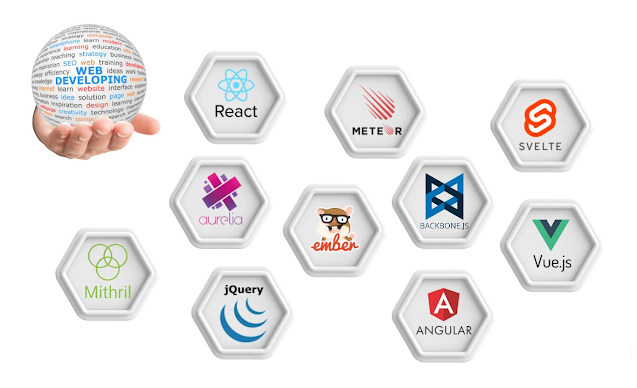Top 10 Front-End Frameworks for Modern Web Development!
In the ever-evolving landscape of web development, staying up-to-date with the latest technologies and tools is essential. Front-end frameworks play a pivotal role in creating visually appealing, responsive, and user-friendly websites. Whether you operate as a web development company providing website development services or specialize in eCommerce development, the selection of the appropriate front-end framework holds substantial sway over the outcomes of your projects. In this article, we’ll explore the top 10 front-end frameworks for modern web development, helping you make informed choices for your next project.
1. React
React, developed and maintained by Facebook, has emerged as one of the most popular front-end libraries for building dynamic and interactive user interfaces. Its component-based architecture allows for the creation of reusable UI elements, making it a favorite among web developers. React’s large community and extensive ecosystem make it a solid choice for various web development projects, including eCommerce development.
Declarative Component-Based Architecture:
React’s core philosophy centers on building UIs as a composition of reusable components. This approach enables developers to describe how the UI should appear for any given state. React takes care of efficiently updating the UI when the data changes. This makes it ideal for projects of all sizes, from small-scale websites to large-scale eCommerce development.
Virtual DOM:
React introduces the Virtual DOM, a virtual representation of the actual DOM. Instead of manipulating the DOM directly, React calculates the differences between the virtual and actual DOM and updates only what’s necessary. This minimizes real DOM manipulations, resulting in faster and more efficient rendering. Such optimization is invaluable for quick-response requirements in eCommerce platforms.
Reusable and Composable Components:
React encourages the creation of reusable components, which are encapsulated UI pieces that can be easily integrated into different project parts. This modular approach enhances code maintainability, fostering structured and organized codebases. For companies offering website development services, this translates into faster development, cost reduction, and smoother collaboration.
Vast Ecosystem:
React’s success is bolstered by its extensive ecosystem, featuring a rich library of pre-built components and a dynamic community. Open-source libraries created and maintained by this community provide solutions to common development challenges. This robust ecosystem ensures React’s reliability, even for specialized requirements in development services.
Seamless Integration:
React is highly adaptable and can integrate smoothly with other libraries and frameworks. It can work with state management tools like Redux for complex applications or pair with server-side rendering (SSR) frameworks like Next.js to optimize SEO performance. This adaptability makes React a versatile choice for various web development projects, including eCommerce development.
Strong Community and Resources:
React’s active and expansive community offers abundant resources, including documentation, tutorials, and forums. Developers can swiftly find answers to queries and stay updated with the latest in the React ecosystem. This support network is invaluable for companies aiming to deliver top-notch website development services.
2. Angular
Angular, maintained by Google, is a comprehensive front-end framework for building robust web applications. It offers features like two-way data binding, dependency injection, and a powerful CLI for streamlined development. Angular is ideal for large-scale web applications and is frequently used in enterprise-level projects.
Comprehensive Web Application Development:
Angular is celebrated for its capacity to handle web applications of varying sizes and complexities. Whether it’s a simple website or a large-scale enterprise project, Angular equips developers with the tools and structure needed to create sophisticated and scalable applications, making it an all-encompassing solution.
Two-Way Data Binding:
Angular’s hallmark feature is its two-way data binding. This means that any changes made in the user interface (UI) automatically update the underlying data model and vice versa. This bidirectional synchronization streamlines development by reducing manual data manipulation, elevating the user experience, and ensuring data consistency. For web development services, this translates to accelerated development cycles.
Dependency Injection:
Angular incorporates a robust dependency injection system, allowing developers to efficiently manage components and services within their application. Dependency injection fosters modularity, reusability, and code maintainability, particularly beneficial in extensive projects where intricate component interactions are frequent.
Command-Line Interface (CLI):
Angular’s Command-Line Interface (CLI) is a developer’s best friend, simplifying various development aspects. It aids in project setup, scaffolding, testing, and deployment. By enforcing best practices and providing a standardized project structure, the CLI reduces development time and potential errors. This tool is invaluable for IT companies, streamlining project management and workflows.
Enterprise-Ready:
Angular’s architecture and features render it highly suitable for enterprise-level projects. Its modularity and scalability are indispensable for managing substantial and intricate applications with numerous components and complex business logic. As such, Angular emerges as the favored choice for handling high-performance, maintainable, and long-term support projects.
Thriving Community and Ecosystem:
Angular enjoys robust community support. This community-driven backing ensures that Angular remains up-to-date with the latest features and best practices. It also grants access to a vast array of third-party libraries, extensions, and tools, augmenting Angular’s capabilities and reducing development effort.
Consistency and Maintainability:
Angular instills consistency in coding style and structure across a project, heightening code maintainability. This consistency proves pivotal for web IT and Software Development `companies engaged in projects requiring continuous updates and enhancements.
Progressive Web App (PWA) Support:
Angular natively supports Progressive Web App (PWA) development. PWAs merge web and mobile app functionalities to provide an enriched user experience. For IT and Software Development companies aiming to deliver responsive and engaging applications, this support is a significant advantage.
Angular’s comprehensive feature set, scalability, and unwavering community support make it an exceptional choice for companies handling projects of diverse scales and complexities. Whether the task at hand is a small website or an extensive enterprise-level application, Angular’s capabilities, including two-way data binding, dependency injection, and the CLI, empower developers to construct robust and efficient web applications that align with the requirements of modern web development.
3. Vue.js
Vue.js is known for its simplicity and flexibility. It’s a progressive framework that can be integrated into existing projects without much hassle. Vue’s gentle learning curve and well-documented API make it a fantastic choice for both beginners and seasoned developers. Its versatility also makes it suitable for Shopify development.
4. Ember.js
Ember.js is a framework that prioritizes convention over configuration, reducing development time by providing a set of predefined patterns and structures. It’s highly suitable for ambitious web applications and is equipped with a router, templating engine, and data layer. Ember’s stability and strong community support make it a reliable choice for long-term projects.
Convention Over Configuration:
Ember.js follows the philosophy of “convention over configuration,” meaning it provides a set of predefined patterns and structures. This approach streamlines development by reducing decision fatigue and enforcing best practices. Developers can focus on building features rather than spending time configuring the framework, making it highly efficient for software development.
Well-Equipped:
Ember.js comes equipped with essential tools for web application development. It boasts a powerful router that simplifies URL routing and navigation. Additionally, Ember features a robust templating engine for creating dynamic user interfaces and a data layer for efficient data management. These built-in components save time and effort in the development process.
Ambitious Web Applications:
Ember.js is tailored for ambitious web applications, which often entail complex requirements and extensive interactivity. The framework’s structure and conventions are well-suited to handle large-scale projects, making it an ideal choice for IT and software development companies tackling intricate applications.
Stability and Longevity:
Ember.js prioritizes stability, which is crucial for long-term projects. It has a strong commitment to backward compatibility, ensuring that applications built today will continue to function correctly in the future. This reliability makes Ember.js a reliable choice for working on projects with extended lifecycles.
Vibrant Community:
Ember.js benefits from a dedicated and active community. This community support leads to consistent updates, valuable documentation, and a wealth of third-party add-ons and extensions. For software development companies, a vibrant community ensures that developers have access to the latest tools and solutions, aiding in problem-solving and project success.
Ember.js excels in simplifying development through its convention-over-configuration approach. Its well-equipped toolbox, suitability for ambitious web applications, commitment to stability, and strong community support make it a dependable choice for web development services, especially when working on projects with long-term commitments and intricate requirements.
5. Svelte
Svelte is a relatively new front-end framework that compiles your code to highly efficient JavaScript during build time. It eliminates the need for a runtime framework, resulting in faster load times and a smaller bundle size. Svelte’s simplicity and performance benefits make it an excellent choice for modern web development.
6. jQuery
jQuery, although not a framework in the traditional sense, is a popular JavaScript library that simplifies DOM manipulation and event handling. It’s lightweight and can be used alongside other frameworks or libraries to enhance the user experience on websites. While its popularity has waned with the rise of modern frameworks, jQuery remains relevant for certain use cases.
7. Backbone.js
Backbone.js is a minimalistic front-end framework that provides the structure necessary for building web applications. It’s especially suitable for projects that require more control and flexibility over the architecture. While it may not be as feature-rich as some other frameworks, Backbone’s simplicity can be an advantage for specific development scenarios.
8. Aurelia
Aurelia is a front-end framework known for its simplicity and extensibility. It follows modern standards like ECMAScript and offers a modular approach to building web applications. Aurelia’s documentation and community support are continually improving, making it a viable choice for web developers.
Simplicity and Modern Standards:
Aurelia is celebrated for its simplicity and its commitment to modern web standards, including ECMAScript (JavaScript) and Web Components. It embraces a minimalist approach that allows developers to write clean and concise code. This simplicity in design and adherence to contemporary standards make it an attractive choice for companies aiming for efficient, future-proof solutions.
Modular Architecture:
Aurelia adopts a modular architecture that promotes the separation of concerns in web development. This approach allows developers to create and manage individual components and features separately, enhancing code reusability, maintainability, and collaboration. With modular development, companies can streamline their workflows and deliver projects more efficiently.
Flexibility and Extensibility:
Aurelia’s extensibility is a standout feature. Developers can easily integrate third-party libraries and plugins into their projects, tailoring the framework to specific project requirements. This flexibility empowers companies to create custom solutions while leveraging Aurelia’s core strengths.
Strong Community and Documentation:
While not as extensive as some other frameworks, Aurelia’s community and documentation are steadily growing and improving. The community’s dedication to the framework ensures that developers have access to valuable resources, such as tutorials, forums, and plugins. This support network is crucial for software development companies as it facilitates problem-solving and knowledge-sharing, ultimately enhancing project outcomes.
Progressive Framework:
Aurelia is often described as a “progressive framework,” meaning developers can adopt it incrementally. Whether you’re starting a new project or integrating Aurelia into an existing one, its modular nature and gradual learning curve make the transition smooth. This versatility accommodates a wide range of project scenarios, from small-scale websites to more extensive web applications.
Rich Templating System:
Aurelia’s templating system allows developers to create dynamic and interactive user interfaces with ease. The two-way data binding and powerful templating engine simplify the process of building responsive and engaging web applications. This is particularly valuable for IT companies looking to deliver top-notch user experiences.
Cross-Browser Compatibility:
Aurelia strives for excellent cross-browser compatibility. This ensures that applications built with Aurelia run smoothly on various browsers, reducing compatibility-related challenges and enhancing the user experience.
Developer-Friendly CLI:
Aurelia provides a Command-Line Interface (CLI) that assists developers with project setup and management. The CLI simplifies common development tasks, streamlining the development process and allowing companies to focus on creating exceptional web applications.
Aurelia’s simplicity, extensibility, adherence to modern standards, and growing community support make it an appealing choice for web development companies and website development services. Its modular architecture and flexibility enable developers to craft efficient and customizable solutions, while its gradual learning curve accommodates projects of different scales and complexities. Aurelia is a versatile framework that empowers developers to create modern, responsive, and user-friendly web applications.
9. Meteor
Meteor is a full-stack JavaScript framework that includes both front-end and back-end components. It allows for real-time data synchronization, making it an excellent choice for applications requiring instant updates. While it may not be as widely adopted as some other frameworks, Meteor’s unique features make it a compelling option for specific projects.
10. Mithril
Mithril is a lightweight front-end framework designed for simplicity and speed. It’s ideal for single-page applications (SPAs) and offers a virtual DOM for efficient updates. Mithril’s minimalistic approach makes it easy to learn and integrate into projects where performance is crucial.
Ultimately, the front-end framework you choose depends on what your web development project needs. React, Angular, and Vue.js are popular, but newer options like Svelte and Aurelia are worth considering. Think about how big your project is, how well your team knows the framework, and what your long-term goals are. Whether you’re a company that builds websites or specializes in Shopify, picking the right front-end framework really matters for the success of your projects. Keep up with the latest trends and technologies in web development to give your clients the best solutions.
Article Resource Link-: https://creativeintelligent.com/top-10-front-end-frameworks-for-modern-web-development/




Comments
Post a Comment